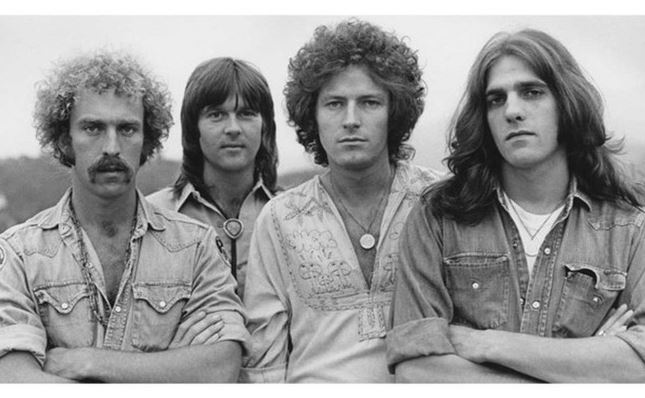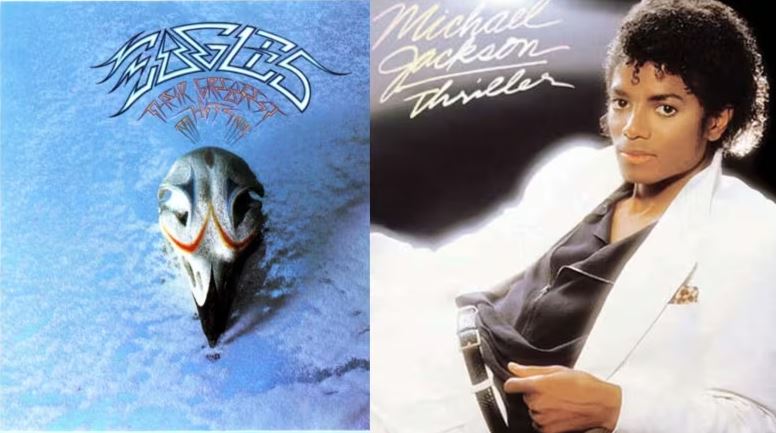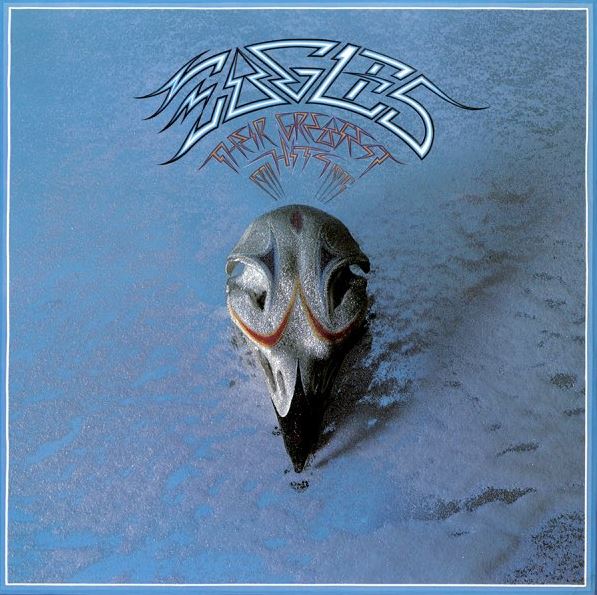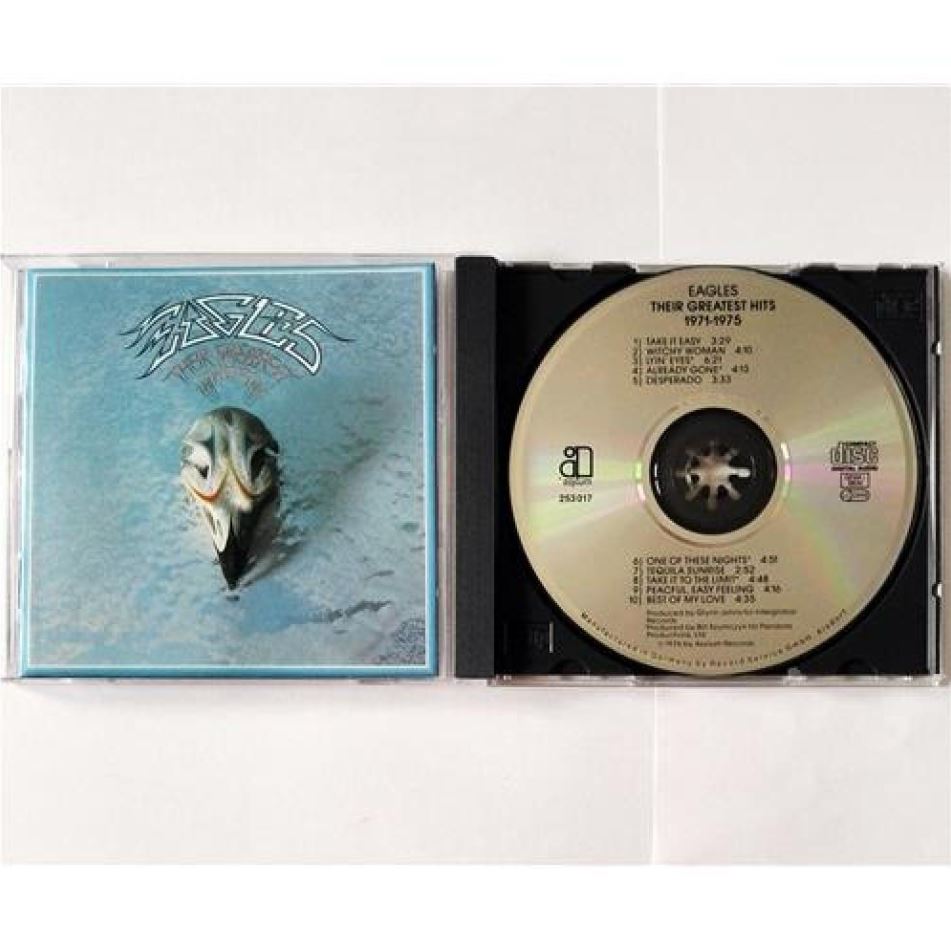“Their Greatest Hits (1971–1975)” stands as a monumental release in the annals of rock music, not only as the Eagles’ first compilation album but also as a record-breaking commercial juggernaut. Released on February 17, 1976, by Asylum Records, this album encapsulates the soaring success and the quintessential sound of the Eagles during the early years of their illustrious career. This compilation showcases a selection of tracks from the band’s formidable first four studio albums—albums that were all released within a remarkably short span from 1972 to 1975.
The timing of the album’s release was both strategic and symbolic, coming at a time when the music industry was burgeoning with rock bands, yet few had achieved such a rapid and prolific output of hits. “Their Greatest Hits (1971–1975)” was not just a reflection of the Eagles’ commercial success but also a strategic move to consolidate and further fuel the band’s growing popularity. Its launch was set against the backdrop of an evolving music industry landscape that was increasingly driven by album sales and radio play. This era saw the rise of album-oriented rock (AOR) radio stations, which played a pivotal role in propelling the Eagles to the forefront of the American rock music scene.
Moreover, the album’s release coincided with the introduction of the Recording Industry Association of America’s (RIAA) platinum certification in 1976, a new accolade to acknowledge album sales surpassing one million copies. “Their Greatest Hits (1971–1975)” was the first album to be awarded this certification, setting a precedent and underscoring its widespread appeal and significant impact. This collection not only highlighted the Eagles’ ability to blend rock with elements of country and folk but also solidified their status as icons of the classic rock genre.
| Feature | Details |
|---|---|
| Album Title | Their Greatest Hits (1971–1975) |
| Release Date | February 17, 1976 |
| Record Label | Asylum Records |
| Content | Tracks from the first four studio albums (1972-1975) |
| Significance | First album to receive RIAA platinum certification |
| Impact | Propelled the Eagles to the forefront of American rock music |
Contents
Album Overview
“Their Greatest Hits (1971–1975)” is a distillation of the Eagles’ early years, encompassing selections from their first four seminal albums: “Eagles” (1972), “Desperado” (1973), “On the Border” (1974), and “One of These Nights” (1975). This compilation was meticulously curated to include nine singles that charted between 1972 and 1975, along with the album track “Desperado,” a song that, despite never being released as a single, became one of the band’s most revered tracks. Among the chosen singles, tracks like “One of These Nights” and “Best of My Love” both reached the top of the Billboard Hot 100, showcasing the Eagles’ knack for crafting hits that resonated with a broad audience.

Upon its release, the album achieved monumental success on the U.S. Billboard 200 chart, debuting at number four and quickly ascending to the number one position the following week, where it remarkably remained for five consecutive weeks. The album’s influence persisted, evidenced by its impressive total of 422 weeks spent on the Billboard 200 as of September 2023. This enduring presence highlights not only the timeless appeal of the Eagles’ music but also its continued relevance and popularity across generations.
| Feature | Details |
|---|---|
| Album | Their Greatest Hits (1971–1975) |
| Included Albums | Eagles (1972), Desperado (1973), On the Border (1974), One of These Nights (1975) |
| Notable Tracks | “One of These Nights”, “Best of My Love” (both Billboard Hot 100 #1s), and “Desperado” (album track) |
| Chart Achievements | Debuted at #4 on Billboard 200, peaked at #1 for 5 consecutive weeks, spent a total of 422 weeks on Billboard 200 as of September 2023 |
| Significance | Highlights the Eagles’ early years and their knack for creating enduring hits |
Historical Significance
The historical impact of “Their Greatest Hits (1971–1975)” is multi-faceted, marked by several significant milestones in the music industry. Most notably, it was the first album ever to receive the Recording Industry Association of America (RIAA) platinum certification, a new standard introduced in 1976 to acknowledge albums that shipped at least one million copies within the United States. This certification was a testament to the album’s overwhelming commercial success and set a benchmark for future releases in the music industry.
The album’s achievements on various charts further cement its legendary status. It was ranked number four on Billboard’s year-end album chart for 1976, demonstrating its dominance in that year. Over the years, it has amassed a total of 422 weeks on the Billboard 200, making it one of the longest-charting albums in the history of the chart. Its continued presence underscores its lasting appeal and the enduring legacy of the Eagles’ music.

In 2017, “Their Greatest Hits (1971–1975)” received one of its highest honors when it was selected by the Library of Congress for preservation in the National Recording Registry. This inclusion was granted on the basis that the album was “culturally, historically, or aesthetically significant.” The recognition by the Library of Congress highlights the album’s profound impact on American culture and its representation of a pivotal era in music history. It acknowledges the Eagles’ contribution to the arts and the enduring value of their music as an integral part of America’s cultural and musical heritage.
These milestones not only reflect the commercial success and widespread acclaim of “Their Greatest Hits (1971–1975)” but also its role in shaping the musical landscape of the 1970s and beyond. The album’s historical significance is evident in its sales, its critical reception, and its ability to resonate with listeners decades after its release, proving it to be a timeless piece of musical history.
| Historical Milestone | Details |
|---|---|
| RIAA Platinum Certification | First album to receive this certification, acknowledging shipments of at least one million copies in the U.S., introduced in 1976. |
| Billboard Year-End Chart (1976) | Ranked number four, indicating its dominance in that year. |
| Longevity on Billboard 200 | Amassed a total of 422 weeks on the chart, marking it as one of the longest-charting albums in history. |
| Inclusion in National Recording Registry (2017) | Selected by the Library of Congress for preservation due to its cultural, historical, or aesthetic significance. |
| Legacy and Impact | The album’s success and recognition underscore its profound impact on American culture and its pivotal role in music history. |
Background and Production
The decision to release “Their Greatest Hits (1971–1975)” was not born solely out of a desire to showcase the Eagles’ early hits but also as a strategic move influenced by the evolving dynamics of the music industry and the band’s own trajectory. Manager Irving Azoff articulated the practicality behind this move, noting, “We decided it was time to put out the first greatest-hits because we had enough hits.” This pragmatic approach aimed to capitalize on the band’s burgeoning popularity and ensure a continuous presence in the market while they worked on future projects.

However, the compilation album was not without controversy among the band members themselves. Guitarist Don Felder revealed that the band members had little say in the decision, expressing a common sentiment that the album was “nothing more than a ploy by the record company to sell product without having to pay additional production costs.” This perspective highlighted a tension between artistic integrity and commercial pressures often faced by bands at the peak of their popularity.
Don Henley, in particular, was vocally critical of the album’s release, especially concerning the context in which some songs were presented. He lamented that iconic tracks like “Tequila Sunrise” and “Desperado” were lifted out of their original album contexts, which he felt was detrimental to the nature, quality, and meaning of the music. Henley’s critique touched on a broader issue within the music industry, where the artistic vision can sometimes be compromised for commercial gains. Despite these reservations, the band acknowledged that the compilation gave them valuable time to perfect their next studio album, “Hotel California,” which would itself become a monumental success.
| Aspect | Details |
|---|---|
| Strategic Release | Manager Irving Azoff’s decision to release the compilation was driven by the need to capitalize on the band’s popularity and maintain market presence while working on future projects. |
| Controversy Among Band Members | Guitarist Don Felder expressed that the decision felt like a record company ploy to sell more albums without additional production costs, indicating tension between artistic integrity and commercial pressures. |
| Critique by Don Henley | Henley criticized the removal of songs like “Tequila Sunrise” and “Desperado” from their original album contexts, arguing it undermined the music’s nature, quality, and meaning. |
| Artistic vs. Commercial Tension | The album highlighted the ongoing conflict within the music industry between preserving artistic vision and achieving commercial success. |
| Impact on Future Work | The release allowed the band additional time to perfect their next album, “Hotel California,” which became another major success. |
Artwork
The artwork of “Their Greatest Hits (1971–1975)” is as distinctive as the music it encases. Created by artist Boyd Elder, also known as “El Chingadero,” the cover features a striking piece of art—a painted plastic cast of an eagle skull set against a shimmering light-blue background made of silver mylar. Elder’s choice of materials and the execution of the design were both innovative and visually arresting, capturing the essence of the Eagles’ artistry in a single, compelling image.
The background’s bumpy appearance gave rise to an enduring myth among fans and observers: that it was covered in cocaine powder, which the band allegedly snorted after the photo shoot. This rumor, while unfounded, was never explicitly denied by the band, adding a layer of rock-and-roll mystique to the album’s legend. Glenn Frey reportedly noticed the resemblance to cocaine as well and mentioned to Elder that it reminded him of “a field of blow,” using the slang term for the drug. This anecdote, whether true or embellished, played into the wild, rebellious image often associated with rock stars of that era.

The artist, Boyd Elder, was compensated $5,000 for his work, a fee that belied the lasting impact and iconic status the artwork would achieve. The album cover not only encapsulated the Eagles’ thematic focus on Americana and rugged individualism but also stood out visually among other album covers of the time, further cementing the Eagles’ brand in the cultural consciousness.
The artwork and the music of “Their Greatest Hits (1971–1975)” together created a powerful synergy that helped propel the album to unprecedented commercial heights. The cover became a visual symbol of the album’s themes and its era, as much a part of its success as the tracks it contained. As the album continues to be celebrated decades later, the artwork remains a testament to the unique aesthetic and cultural impact of the Eagles during the golden era of rock music.
| Aspect | Details |
|---|---|
| Artist | Boyd Elder, also known as “El Chingadero” |
| Description | Painted plastic cast of an eagle skull against a light-blue background made of silver mylar |
| Visual Effect | Striking and innovative design that captures the essence of the Eagles’ artistry |
| Myth | An unfounded rumor that the bumpy background was covered in cocaine, adding a layer of rock-and-roll mystique |
| Impact | The artwork helped to cement the Eagles’ brand and themes of Americana and rugged individualism, contributing significantly to the album’s success |
Critical Reception
“Their Greatest Hits (1971–1975)” was met with a mixture of acclaim and scrutiny upon its release. Professional critics and music aficionados alike have weighed in over the years, contributing to a rich tapestry of evaluations. William Ruhlmann of AllMusic praised the compilation for its cohesion and immediate engagement, remarking that the album “works so much better than the band’s previous discs and practically makes them redundant.” Christgau’s Record Guide was slightly more reserved, giving the album a B rating, indicative of good quality but not without its flaws. Meanwhile, The Rolling Stone Album Guide provided a nuanced view that balanced the album’s historical significance with its artistic merit.

Public and critical polls have also reflected the album’s enduring popularity. In a 1978 survey of 50 rock critics and DJs, the album was ranked number 141, showcasing its respected place among contemporaries. Furthermore, it was voted as the sixth-best compilation album in the 1994 edition of All Time Top 1000 Albums, signaling its continued relevance and impact within the broader musical landscape.
| Source | Comment/Rating | Significance |
|---|---|---|
| AllMusic (William Ruhlmann) | Praised for cohesion and immediate engagement; viewed as superior to previous discs. | Highlights the album’s effectiveness and impact compared to earlier works. |
| Christgau’s Record Guide | Rated B; described as good quality with some flaws. | Indicates a more reserved but still positive reception. |
| The Rolling Stone Album Guide | Nuanced view balancing historical significance with artistic merit. | Provides a balanced critique acknowledging both strengths and artistic context. |
| 1978 Rock Critic Poll | Ranked number 141 among contemporaries. | Shows respect and a solid ranking among other significant albums of the time. |
| All Time Top 1000 Albums (1994) | Voted as the sixth-best compilation album. | Reflects enduring popularity and impact within the broader musical landscape. |
Commercial Performance
Commercially, “Their Greatest Hits (1971–1975)” set numerous records that still stand. It debuted at number four on the U.S. Billboard 200 album chart and ascended to the number one spot the following week, where it remained for five consecutive weeks. Its longevity is perhaps even more impressive; the album has spent a total of 422 weeks on the Billboard 200 as of September 2023. This staying power is a testament to the album’s widespread appeal and the timeless quality of its music.

The album’s initial and continued certifications reveal its massive commercial success. It was the first ever to receive the Recording Industry Association of America’s (RIAA) platinum certification, marking sales of one million units. Over the years, it was certified multiple times, reaching 38 times platinum by August 2018, making it one of the best-selling albums of all time in the United States. However, these certifications have not been without controversy. Skepticism arose from various corners regarding the RIAA’s counting methods, especially in the wake of digital music sales and streaming. Critics have pointed out discrepancies in sales figures and certification counts, suggesting that these numbers may not fully represent actual sales but rather an aggregation of multiple metrics that include streaming.
| Aspect | Details |
|---|---|
| Billboard 200 Performance | Debuted at #4, peaked at #1 for five consecutive weeks, and spent a total of 422 weeks on the chart as of September 2023. |
| RIAA Certifications | First album to receive platinum certification; reached 38 times platinum by August 2018, making it one of the best-selling albums in the U.S. |
| Certification Controversy | Critics have questioned the RIAA’s counting methods, particularly in the digital era, suggesting discrepancies in sales figures and the inclusion of streaming in certification counts. |
Worldwide Impact
Globally, “Their Greatest Hits (1971–1975)” has made significant inroads, selling over 45 million copies worldwide as of 2020. This makes it not only the best-selling greatest hits album of all time but also one of the top three best-selling albums overall. It has received numerous international certifications, including 8× Platinum in Australia and 2× Diamond in Canada, reflecting its universal appeal and the global reach of the Eagles’ music.
The album’s impact extends beyond just numbers; it has influenced generations of musicians and continues to be a staple in the collections of music lovers across the globe. Its blend of rock, country, and folk elements, packaged in a format accessible to a wide audience, has ensured its place in the annals of music history as a cultural and artistic milestone.

In sum, “Their Greatest Hits (1971–1975)” remains a landmark achievement for the Eagles. Its critical reception, commercial success, and lasting impact on music both in the United States and around the world underscore its importance as not just a record of hits, but as a historical artifact that captures the essence of an era in music.
| Aspect | Details |
|---|---|
| Global Sales | Over 45 million copies sold worldwide as of 2020, making it one of the top three best-selling albums globally. |
| International Certifications | 8× Platinum in Australia, 2× Diamond in Canada, among other international certifications. |
| Cultural Impact | Influenced generations of musicians; a staple in music collections worldwide, showcasing the universal appeal of the Eagles’ music. |
| Artistic Significance | Represents a cultural and artistic milestone in music history; its blend of rock, country, and folk elements has solidified its legacy. |
Track Listing
“Their Greatest Hits (1971–1975)” features a meticulously curated selection of the Eagles’ most iconic songs from their early career. This compilation includes:
- “Take It Easy” (from “Eagles,” 1972) – Written by Glenn Frey and Jackson Browne, this track features Frey on lead vocals and lasts 3:29. It epitomizes the laid-back Southern California sound that became synonymous with the band.
- “Witchy Woman” (from “Eagles”) – Don Henley and Bernie Leadon penned this song, with Henley taking the lead vocals. The track duration is 4:10 and is known for its haunting melody and mystical lyrics.
- “Lyin’ Eyes” (from “One of These Nights,” 1975) – Another Henley and Frey collaboration, with Frey on lead vocals, running for 6:21. This song tells a story of infidelity and disillusionment within a relationship.
- “Already Gone” (from “On the Border,” 1974) – Written by Robb Strandlund and Jack Tempchin, sung by Frey, and lasting 4:13. It’s a liberating song about breaking free from a relationship.
- “Desperado” (from “Desperado,” 1973) – A Henley and Frey composition, featuring Henley on lead vocals for a duration of 3:33. This song has become one of the band’s most beloved ballads.
- “One of These Nights” (from “One of These Nights”) – Henley and Frey crafted this title track, with Henley leading the vocals, spanning 4:51. The song features a smooth, soulful vibe and complex harmonies.
- “Tequila Sunrise” (from “Desperado”) – Another creation by Henley and Frey, sung by Frey, with a length of 2:52. It’s a reflective song about moving on and facing a new day.
- “Take It to the Limit” (from “One of These Nights”) – This song was co-written by Randy Meisner, Henley, and Frey, featuring Meisner on lead vocals and lasting 4:48. It’s known for its poignant lyrics and memorable chorus.
- “Peaceful Easy Feeling” (from “Eagles”) – Written by Jack Tempchin and sung by Frey, this track runs for 4:16 and is celebrated for its soothing melody and comforting lyrics.
- “Best of My Love” (from “On the Border”) – Penned by Henley, Frey, and J.D. Souther, Henley leads the vocals for 4:35. This track became one of the band’s first major hits, topping the charts and defining their early sound.
| Song | Album | Duration | Lead Vocals | Songwriters |
|---|---|---|---|---|
| Take It Easy | Eagles (1972) | 3:29 | Glenn Frey | Glenn Frey, Jackson Browne |
| Witchy Woman | Eagles | 4:10 | Don Henley | Don Henley, Bernie Leadon |
| Lyin’ Eyes | One of These Nights (1975) | 6:21 | Glenn Frey | Don Henley, Glenn Frey |
| Already Gone | On the Border (1974) | 4:13 | Glenn Frey | Robb Strandlund, Jack Tempchin |
| Desperado | Desperado (1973) | 3:33 | Don Henley | Don Henley, Glenn Frey |
| One of These Nights | One of These Nights | 4:51 | Don Henley | Don Henley, Glenn Frey |
| Tequila Sunrise | Desperado | 2:52 | Glenn Frey | Don Henley, Glenn Frey |
| Take It to the Limit | One of These Nights | 4:48 | Randy Meisner | Randy Meisner, Don Henley, Glenn Frey |
| Peaceful Easy Feeling | Eagles | 4:16 | Glenn Frey | Jack Tempchin |
| Best of My Love | On the Border | 4:35 | Don Henley | Don Henley, Glenn Frey, J.D. Souther |
Personnel and Production
Band Members
- Glenn Frey – Guitars, vocals, piano on various tracks.
- Don Henley – Drums, vocals, and the primary voice on several of the compilation’s key songs.
- Bernie Leadon – Guitars, backing vocals, banjo, pedal steel, and mandolin, adding a distinctive country flavor to the tracks.
- Randy Meisner – Bass guitar, vocals, notably leading on “Take It to the Limit.”
- Don Felder – Guitars, organ on select tracks like “Lyin’ Eyes” and “Already Gone,” contributed after joining the band in 1974.
Production Team
- Producers: Glyn Johns and Bill Szymczyk played crucial roles in shaping the sound of the Eagles during this period. Johns worked on the earlier albums, while Szymczyk took over for later projects, bringing a more rock-oriented sound.
- Engineers: The engineering team included Allan Blazek, Michael Braunstein, Howard Kilgour, Ed Mashal, Michael Verdick, and Don Wood, who were instrumental in capturing the iconic sound of the Eagles in the studio.
- Art Direction and Design: Henry Diltz and Glen Christensen were responsible for the album’s visual presentation, alongside Boyd Elder, who created the memorable album cover.

The production and recording of these tracks involved a blend of meticulous studio work and innovative sound engineering, ensuring that each song not only captured the essence of the Eagles’ style but also stood the test of time. The collaboration between the band members and their production team resulted in a compilation that not only highlighted their hits but also showcased their evolution as artists during a pivotal time in rock history.
| Role | Member | Contribution |
|---|---|---|
| Band Member | Glenn Frey | Guitars, vocals, piano on various tracks. |
| Band Member | Don Henley | Drums, vocals, primary voice on several key songs. |
| Band Member | Bernie Leadon | Guitars, backing vocals, banjo, pedal steel, mandolin, adding a country flavor. |
| Band Member | Randy Meisner | Bass guitar, vocals, notably on “Take It to the Limit.” |
| Band Member | Don Felder | Guitars, organ on select tracks like “Lyin’ Eyes” and “Already Gone.” |
| Producer | Glyn Johns | Shaped the sound on earlier albums. |
| Producer | Bill Szymczyk | Took over for later projects, introducing a more rock-oriented sound. |
| Engineer | Allan Blazek, Michael Braunstein, Howard Kilgour, Ed Mashal, Michael Verdick, Don Wood | Instrumental in capturing the iconic sound in the studio. |
| Art Direction and Design | Henry Diltz, Glen Christensen, Boyd Elder | Responsible for the visual presentation of the album, including the memorable cover art. |
Charts and Certifications
Since its release in 1976, “Their Greatest Hits (1971–1975)” by the Eagles has not only enjoyed immense commercial success but has also made an indelible mark on the music charts. Initially debuting at number four on the U.S. Billboard 200, it swiftly climbed to the number one spot, where it remained for five consecutive weeks. Over the years, the album has achieved a remarkable tenure on the Billboard 200, totaling an impressive 422 weeks as of September 2023. This long-standing presence is a testament to its enduring appeal and consistent sales.

Internationally, the album’s performance has been equally stellar. It has secured top positions on charts around the globe, including reaching the top ten in countries like Australia, Canada, and the United Kingdom, underscoring its worldwide appeal.
In terms of certifications, “Their Greatest Hits (1971–1975)” has received numerous accolades that reflect its massive sales volumes:
- United States: Certified 38x Platinum by the RIAA, making it one of the best-selling albums in U.S. history.
- Australia: Achieved 8x Platinum status, indicating high sales figures.
- Canada: Earned a 2x Diamond certification, further demonstrating its popularity.
- United Kingdom: Certified Platinum, showcasing significant sales in a major music market.
These certifications not only highlight the album’s widespread acclaim but also illustrate its ability to transcend geographical and cultural boundaries, resonating with diverse audiences across the globe.
| Region | Chart Performance | Certification |
|---|---|---|
| United States | Debuted at #4, peaked at #1 for five weeks, 422 weeks on Billboard 200 as of September 2023 | 38x Platinum by the RIAA |
| Australia | Top ten position | 8x Platinum |
| Canada | Top ten position | 2x Diamond |
| United Kingdom | Top ten position | Platinum |
Reflecting on the legacy of “Their Greatest Hits (1971–1975),” it’s clear that this compilation album is more than just a collection of songs; it’s a cultural artifact that encapsulates a pivotal moment in the history of rock music. The Eagles managed to distill the essence of their early career into a single album that continues to influence artists and entertain audiences decades after its release.
The album’s significance in the music industry is underscored by its groundbreaking achievements, such as being the first album to receive the RIAA’s platinum certification. Its inclusion in the National Recording Registry by the Library of Congress in 2017 as a recording of “culturally, historically, or aesthetically significant” importance further cements its status as a cornerstone of American music.
“Their Greatest Hits (1971–1975)” is not merely a collection of tracks; it is a narrative of musical innovation and excellence that continues to influence the industry. Its ongoing popularity and the reverence it receives are testaments to its artistry and its pivotal role in shaping the landscape of modern music. As we look back on this album, it’s clear that its songs have not only defined a genre but have also become a defining soundtrack for multiple generations.
